Don't wanna be here? Send us removal request.
Text
7.3 Reflection
This blog experience was much the same as my previous experience in my Art Theory course. I know I reverted back to my tried and true gender as performance analysis model many times, but I really appreciated the depth and breadth of pieces I was able to apply that analysis to. I had previously been introduced to Cindy Sherman’s photography and her depiction of female stereotypes but through the research paper I completed I interacted with and formed a new perspective of her work: as the Newtonian opposite to drag impersonation. I’ve written quite a few papers on gender performance and drag in early modern literature but getting to make the connection between camp imitation and grotesque critique was enlightening. Chances are I will write more papers on the connection between drag and gender performance in art.
0 notes
Text
7.2 Research Paper Summary
One of the primary cultural symbols that is present in art is gender signs, or the specific ways in which masculinity and femininity are understood and exemplified in the historical context of a work. While these specific signs are usually tied to the idealized understanding of masculinity and femininity within a culture, the signs are just representations of qualities that can then be used to subvert the typical message of the signs. In their article “Performative Acts and Gender Constitution: An Essay in Phenomenology and Feminist Theory,” Judith Butler asserts that “gender is in no way a stable identity or locos of agency from which various acts proceed” rather that gender is an identity connected to time and “instituted through a stylized repetition of acts” (519). In this way gender signs and signifiers are tied to an idea of performance, adopting the specific signs that represent what one wants to signify as well as establishing a baseline from which to subvert the meanings of the signs and signifying a subversion of gender performance. This idea of gender subversion through the use of gendered signs within art is most prominent in Artemisia Gentilischi’s Judith Slaying Holofernes (figure 1) and Cindy Sherman’s Untitled #205 (figure 2).

Figure 1, Judith Slaying Holofernes, Artemisia Gentileshci, oil on canvas, 1612-13, Pitti collection.

Figure 2, Untitled #205, Cindy Sherman, chromogenic color print, 1989.
The rest of my paper is about analyzing the performative nature of Gentileschi and Sherman’s depiction of femininity in comparison with Caravaggio’s Judith Beheading Holofernes, Orazio Gentileschi’s Judith and Her Maidservant with the Head of Holofernes, and Raphael’s La Fornarina. I also analyze the performative nature of Caravaggio, Orazio, and Raphael’s idealized femininity as a counter to the subversion of societal norms present in Gentileschi and Sherman’s pieces.
1 note
·
View note
Text
7.1 Yoko Ono's Cut Piece
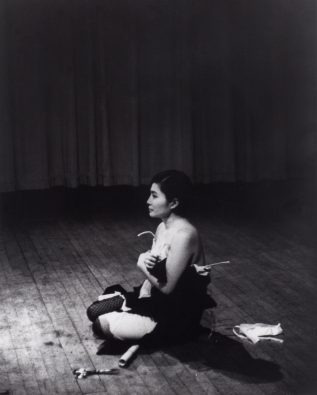
It is unclear which version of Yoko Ono’s Cut Piece the video records, though I’d say from the audio it’s either the New York Carnegie Hall performance in 1965 or London Africa Center in 1966. That being said, I would have to say that Cut Piece is more of a cultural and racial commentary than a feminist commentary. When she originally performed it in Kyoto in 1964, I would say it is more of a feminist piece as there are no colonial or xenophobic biases in the audience as they are all Japanese; thus the gendered expectation of serenity and submissiveness are clearly present. However, when performed in New York and London, the passivity of Ono’s performance and the objectification of Ono by the audience (both being turned into a literal object they can cut away and something to sexually objectify) echoes colonial and xenophobic sentiments. As the piece slowly progressed with more and more of Ono being revealed, the tension and dehumanization of the situation were perfectly highlighted especially with Ono’s barely concealed tears and the obvious laughter at certain moments in reaction to her objectification. Because Ono is Japanese and the audience cutting pieces from her are white, the viewer is forced to address the subjugation of “lesser” peoples and the steadily increasing depletion of their resources at the hands of the more powerful peoples.
0 notes
Text
6.2 Psychoanalytic
Claude Cahun was an other within many aspects of her life, she was a Jewish lesbian surrealist in the early twentieth century. Surrealists were othered within the art world, not considered high art initially, however she was excluded by the surrealist “establishment” itself. Her art challenges and disrupts the ideals of gender, sexual identity, and femininity; she fluidly explores multiple selves within her art and focuses on sexual politics not the sensual body. She staged her photography, breaking with much of surrealist photography continuing the separation between herself and the rest of the surrealist movement. In What Do You Want of Me?, Cahun captures two busts facing away from each other yet looking towards each other. The figures are free of hair, bald and sans eye brows and eyelashes, creating a sense of androgynous bodies rather than gendered bodies. The course notes claim that the image is an interrupted narcissistic dialogue, that is undercuts traditional notions of individual subjectivity; I don’t think I agree. While it could be analyzed as such through a psychoanalytic lens, I feel it more accurately represents the struggle between the id and the superego thus making it a depiction of the ego, the moment of compromise between the two.
In psychoanalytic analysis the id is the unconscious needs and desires of the individual, or as I explain it to my students it is your “hind brain” or “shoulder-devil.” The superego is the conscious recognition of norms and morals inherent in society, this is a portion of the individual that they are both explicitly taught and develop and refine on their own. The superego is the “Jiminey Cricket” or “shoulder-angel” of the individual. The ego represents the simultaneous struggle and compromise between the id and superego, this is where the individual’s identity develops and cements.
Cahun’s piece captures the tension between two figures both critical of and submissive to each other. This tension thus represents the artist’s ego, the struggle to meet their wants and desires with the expectations of society.
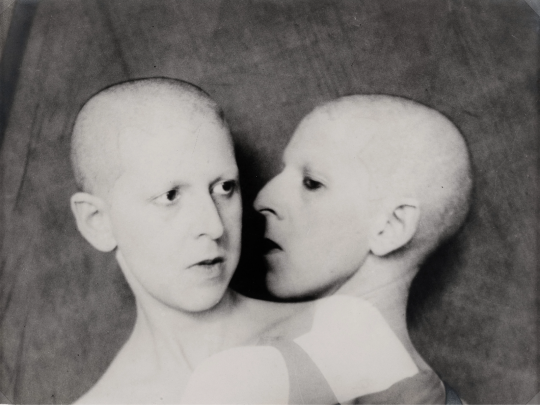
0 notes
Text
6.1 Freedom for Women?
Rather than being a linear progression through movements, modernism is a confusing mash of overlapping movement margins with artists freely galavanting through whatever means to spur art forward into the new century. Impressionism, cubism, surrealism, and pop art are only a few of the many different movements of modernism which overlapped with civil rights, women’s rights, and queer rights movements of the twentieth century.
As far as modernism actually offering women more freedom, I don’t think there is a set answer to that question. There were more opportunities for women within the art world, better education, higher quality opportunities; and over the course of the century women gained the vote, the right to no-fault divorce, the right to financial autonomy, the right to safe abortion. However, the pushback to all those gains was harsh; the Satanic Panic stemmed from fearmongering the perils of women leaving the home to work, the glass ceiling ensured women couldn’t rise above a certain station. Women faced harsher scrutiny and critique within the art world; so while they were afforded better and more opportunities, they were constantly reminded of their inferiority.
0 notes
Text
5.2 19th Century Femininity
The piece I chose for this week was George Hayter’s The Coronation of Queen Victoria in Westminster Abbey, 28 June 1838. The piece is an oil on canvas completed in 1839 and is currently kept in the East Gallary of Buckingham Palace. When looked at as a whole, the primary colors are sumptuous reds and golds with bright white contrasting figures; the mass of figures makes it hard to focus the eye on Victoria, though she is centered just to the right of the center of the field of vision. She is seemingly swamped by her thone, and the size and grandeur of the abbey. I chose this piece specifically because it tread a fine line between depicting the English monarch as a decisive, powerful figure and a passive, feminine figure. This is a decidedly public space, so it emphasizes the ideals of the “new” Victorian femininity, a demure, diminutive figure, both passive and powerful. The lack of private space within the piece emphasizes the necessity of conforming to the established ideals of femininity at all times; just as there is no break from being queen (though Victoria certainly tried to take breaks) there is no break from conforming to the ideals of Victorian society. One could posit that the “new” passivity of femininity in the nineteenth century, and especially during Victoria’s reign, was a result of Victoria making sure she boost’s Albert’s male ego by being submissive to him even though she wildly outranked him. This would seem to track and is again emphasized by Victoria’s diminutive figure in Hayate’s painting.
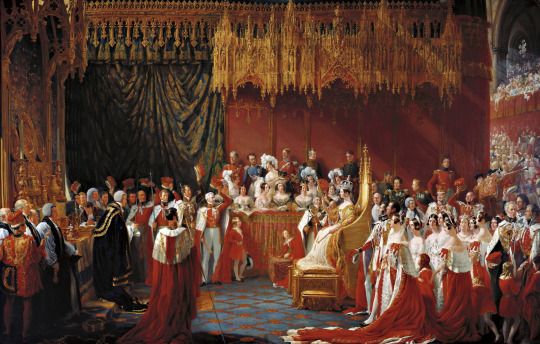
The Coronation of Queen Victoria in Westminster Abbey, 28 June 1838, George Hayter, 1839, Oil on canvas, East Gallary, Buckingham Palace.
0 notes
Text
4.1 Gender Differences
Both Artemisia Gentileschi and Caravaggio created oil on canvas pieces depicting the moment when Judith assassinates Holofernes from the “Book of Judith,” a text included in the Catholic and Eastern Orthodox bible, defined as apocryphal by Protestants, and excluded by the Hebrew canon. In the story, Judith uses her beauty and charm to kill the Assyrian general Holofernes who had besieged her city. The story is meant to represent the paradox of a “good” sin (murdering one man but saving an entire city).
The obvious difference between Gentileschi and Caravaggio’s pieces are the orientation, Caravaggio’s piece is oriented horizontally which allows for a lot of negative space that emphasizes the chariscuro but doesn’t add to the portrayal of the scene. The horizontal orientation creates a clear delineation between the feminine “softness” of Judith and her maid and the masculine gore of Holofernes. Judith’s form is depicted as leaning away from Holofernes and the sword she is using to decapitate him. Her grip is partially obscured behind Holofernes’ head and it is angled in a way that would not have allowed a fraction of the strength she would have needed to sever his head from his body. She is also depicted as wearing a pure white bodice, unstained by the spurting blood which was so kind as to spray away from her form. Her expression shows a pitying practicality, knowing she must do this grizzly deed but seemingly contrite about the murder. By depicting Judith in this way, Caravaggio emphasizes the male gaze of the early modern period, the feminine daintiness necessitated by the patriarchal culture of the time. Despite Judith being forced to make this morally gray decision, she is visibly recoiling from the violence and thus unstained by its execution, remaining non-threatening to the established norms.
In contrast, Gentileschi’s piece is oriented vertically and the scene fills the canvas not allowing for more than fifteen percent of the image to be negative space. In this piece, Holofernes is supine on a stack of mattresses, actively trying to fight off Judith’s maid servant who is pinning his arms to his chest. The maid servant is exerting obvious effort to pin Holofernes, it is clear she is using gravity and her body weight to give her that slight advantage to overpower him. Judith occupies the right of the frame, gripping Holofernes by the hair and forcing his face away from her with her left hand while her right hand holds the sword she is using to cut his head off of his body. Her face shows a calm practicality, similar to Caravaggio’s Judith, but Gentileschi’s Judith is depicted with straining muscles, tendons standing out on her arms as she clearly saws the sword through Holofernes’ neck. Below Holofernes’ head, the sheets are stained with blood and gore, depicted by a deeper red than Caravaggio’s vivid, unrealistic red. Ultimately, Gentileschi’s work depicts a harsher reality of early modern women, capable of seduction and femininity but also capable of taking care of problems by any means necessary.
Understanding Gentileschi and Caravaggio’s biographies color the interpretation of both of their pieces. Caravaggio’s depiction of bloody gore is antithetical to the fact that he murdered a man in a brawl which caused him to flee from Rome to Naples. Knowing that he had first hand experience in violent, masculine struggles emphasizes the idea of femininity he is presenting in his work. Artemisia Gentileschi on the other hand, was the daughter of Orazio Gentileschi, another baroque artist, and was the first woman accepted to the Florentine Academy. According to court records, around the time this piece was created Gentileschi was raped by one of her father’s assistants and her testimony in the court case was only admissable if given under torture. Knowing the reality of Gentileschi’s life around the time of creation, the vengeful practicality of the violence depicted against Holofernes can be seen as a cathartic expression for Gentileschi, though primary documentation is lacking to provide a full psychoanalytic analysis. Whether it was auto-biographical or not, Gentileschi allows her depiction of femininity to contain the typical signs associated with masculine rationality and violence, highlighting the nuance of gender.

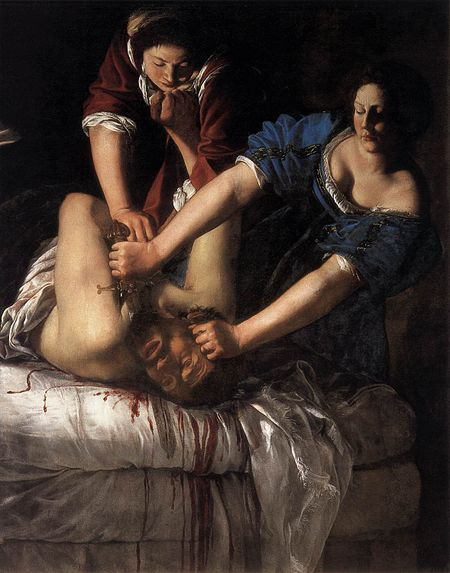
Pointon, Marcia. “Artemesia Gentileschi’s ‘The Murder of Holofernes.’” American Imago, vol. 38, no. 4, 1981, pp. 343–67. JSTOR, http://www.jstor.org/stable/26303770.
2 notes
·
View notes
Text
3.2 Cremaster Cycle
To be quite honest, I’m not entirely sure what to make of Matthew Barney’s Cremaster Cycle. While I understand the allusions to the cremaster muscle and thus the exploration of the masculine identity, I’m not sure if it is taking a hard stance on gender binarism or androgyne. Barney’s work is a series of five feature-length films, related sculptures, photographs, drawings, and artist’s books creating a more immersive artistic impression than just a singular still image, sculpture, or film. While the title references the muscle used to raise and lower the testicles in temperature fluctuations, the project’s visual symbolism and iconography focuses on the parts of embryonic sexual development before the gonads differentiate between testes and ovaries. In this, Barney represents the condition of ultimate potential.
Formalism and semiotics seems like it would be the best lens through which to view the cycle, but again the message seems to be muddled to me. While I currently identify within the queer umbrella and understand the signs and signifiers of modern queerness, I am not well versed in the signs and signifiers of queerness in the nineties and early two thousands. I can clearly see the visual similarities between the Cremaster Cycle and popular music videos of the time, so I recognize the pop culture significance, but the ultimate message Barney is trying to convey is unclear. Of course, it could be that he is trying to emphasize the muddled idea of gender and its signifiers playing with the idea that there is no clear understanding of masculinity, just the potential for gender expression.
0 notes
Text
3.1 Identity
Deborah Kass’s Altered Images #2 is a perfect example of semiotics in art and how they are used to communicate gender and identity. In the middle of the frame, Kass poses in a contraposto stature with her right leg bent and her hands crossed and resting on her right thigh. Her body is facing the right of the piece at a fourty-five degree angle but her face and gaze are directly down the lens of the camera. In this self portrait, Kass is mimicking a photograph of pop artist Andy Warhol dressed as a woman dressing as a man. Since Kass is a woman, dressing as a man, who dressed as a woman dressing as a man, the piece obviously creates layers of gendered signs and signifiers creating a figure that is not quite androgynous but not binary. The makeup Kass uses to emphasize the “femininity” is the typical camp style of drag performers of the late-eighties (echoing Divine) and the outfit she wears consists of a boxy, dress-shirt and wide tie with jeans in a typical masculine cut. The makeup, hair, and outfit are all carefully crafted to emphasize the performance element of gender, that it is not inherent or biological, rather it is a curation of accepted signs “agreed upon” by a society. Judith Butler refers to gender as “an identity instituted through a stylized repetition of acts” and emphasizes “the acts by which gender is constituted bear similarities to performative acts within theatrical contexts.” By utilizing elements of drag performance and masculine fashion, Kass presents gender as a glass onion of sorts, something infinitely complex while simultaneously transparent.

Butler, Judith. “Performative Acts and Gender Constitution: An Essay in Phenomenology and Feminist Theory.” Theatre Journal, vol. 40, no. 4, 1988, pp. 519–31. JSTOR, https://doi.org/10.2307/3207893.
1 note
·
View note
Text
2.2 Women in Film
I feel like Mulvey’s theories on film approach the immersive nature of films in a way that I don’t usually consider films. It provided a meta-textual element to my appreciation of film and made me reflect on those elements that helped develop my identity (recognition of the self through the other baby!!). While I wasn’t a fan of her reliance on Freud’s theories to develop her ideas, I recognize that literature and film analysis aren’t ready to let go of his ideas despite psychologists’ decades-long insistence. Her ideas of gaze in particular are excellent in formatting meta-analysis in film, and the ultimate questions of female agency within stories. The gazes range from the camera that records the events to the audience that is watching the events, and to the characters at each other.
For this post, I viewed the scene from Rear Window where Lisa (Grace Kelley) sneaks into the apartment while Jeff (James Stewart) watches, unable to help. This scene was fun to view with the gazes in mind as it blurs the lines between them and creates a reality where the audience and the characters are one. The establishing shot of the scene shows Lisa crossing to the apartment building and scaling the fire escape in heels and a cocktail dress to enter an open window in the second-floor rear apartment; I’d say this is a moment of scopophilia as Grace Kelley’s Lisa looks quite stunning in the scene. There is pleasure in looking at Lisa breaking and entering while in a full society getup. During the break-in, Jeff is across the road in his apartment watching, unable to go himself because of a broken leg, leaving him impotent in the face of the danger Lisa is bravely facing. While Jeff watches her search the apartment, the man who lives there returns, whom they suspect of murder, and accosts Lisa. Throughout this scene the camera captures the events, cutting between a “first-person” perspective of what Jeff would see across the way, and a “third-person” perspective of watching Jeff and Stella watch Lisa. In this, the viewer of the film is briefly both the audience and the character as we see what Jeff and Stella see, this immersion into the film itself increases the suspense as the audience can no more influence what Lisa is doing than Jeff can. There is less of a voyeuristic quality to the scene, than there is an immersion into the impotence Jeff feels in the plot with his broken leg. The use of differing and overlapping gazes makes the scene so impactful.
0 notes
Text
2.1 Titian's "Rape of Europa"
Berger establishes the concept of looking and seeing as a conscious choice in “Ways of Seeing.” This can be done by examining objects or art within its spheres of interference, both literal and metaphorical. These spheres range from physical barriers to the piece to cultural biases that influence the piece, ironically enough these spheres tend to overlap with the “contextual approaches” of analysis. I am a literature student first and foremost, so I was introduced to these as “literary theory” or “critical lenses” and when I was reading the textbook, I just had to file the new name into my brain. These contextual approaches provide frameworks to analyze art and its impact on and from the world it was created during.
A.W. Eaton uses the feminist approach in discussing Titian’s “Rape of Europa.” Eaton argues that because the context of the story depicted in Titian’s painting is a traumatic kidnapping and rape, it is unethical to praise the aesthetic quality of the work. It is the sensualization and sexualization of a rape victim that makes Titian’s painting “ugly.” Titian’s composition entices the viewer to see Europa as an object of desire, and it keeps the viewer’s eye on Europa’s sensually exposed body, despite the context of the myth.
Personally, I view the piece somewhere in the middle. I can recognize and understand Eaton’s arguments, but I think to say the ethical issues reduce the aesthetic quality of the piece irrevocably is to take it a mite too far. I feel that for the average museum-goer, seeing this piece will trigger an aesthetic response, the composition is dynamic, the colors are saturated beautifully, and the technique displayed is unparalleled. That isn’t bad, it was Titian’s intent. However, that doesn’t mean we should ignore the societal context of Titian’s time or that of the original myth. Natalie Haynes has two fantastic books about reframing women in Greek mythology, Pandora’s Jar and Divine Might, and she speaks to the women Zeus rapes both from their perspectives and that of Hera, and it provides a lot of nuance to their agency within their stories. I feel like that is the approach we must take to Titian’s painting, understanding the context of the time it was made and opening a discussion to the fact that a piece can be contextually problematic and aesthetically appealing.

0 notes
Text
1.3 Gender Influences
Gender has been, for the most part, a huge hindrance to half of the global population for centuries. If you had the "misfortune" to be born without a Y chromosome you were othered by the rest of your community, not permitted to pursue certain jobs, and treated as if you were less than the rest of your community. While it is much better now in the twenty-first century, gender equality has not reached full equity. It isn't super clear and obvious how the social and cultural construction of gender impacts my everyday life personally as I don't receive much gender discrimination. However, I am a public school teacher in the state of Florida and due to certain statutes laid out by certain governors, I have to risk my job in order to treat my students with respect regarding their gender and presentation. While I may consider my gender "factory default" and have just accepted how society perceives me because it's too much for me to perform one gender over another, I know that it is more extreme for others, and I know that I have students who are much more severely impacted by the small-minded cultural construction of gender as shown in my deeply red county. I currently work with one of my former high school teachers, who was censured by the county just two years ago for daring to call a trans student by their chosen name, a common courtesy we afford to cis students wanting to go by a nickname without fuss.
My personal conception of gender is that all gender is a performance particular to the individual that may or may not align with their society's set ideas. Or to put it more succinctly, gender is drag. As such, gender can be a powerful tool of expression in art, but historically (and following the traditional conceptions) gender has made it more difficult to pursue art for half of the population. Understanding these limitations, and means of expression, is important to processing art as a historical movement.
0 notes
Text
7.3 Reflection
The contents of this course were fascinating. I knew some already because studying the theory of art is surprisingly similar to studying the theory of literary criticism, but it is always a blast to read philosophy essays and applying their contents to different works. It was a lot of fun to reread some of the theories I read back in my undergraduate degree like Plato and Kant, and apply them to art rather than literature. This whole process has been a benefit because it has allowed me to reflect on all of these topics and collect them into one place. This will be a good reference for me if I need to remember my thoughts about a certain topic, I can easily search this blog to find those thoughts and transfer them into another essay or work.
0 notes
Text
7.1
Walter Benjamin’s theory of the aura boils down to the specific context that surrounds a piece at a specific point in time. The aura is a product of the culture, history, and present of both the artist and the audience. The best example I have of this is Moby Dick by Herman Melville which was largely forgotten in Melville’s lifetime and the decades following until 1917 when it was “rediscovered” by literary critics. The original aura of the novel didn’t resonate with the audience of the 1850s, it wasn’t until WWI when the soldiers at war had access to the paperbacks and time to “hurry up and wait” that the aura resonated with an audience. This is where I disagree with Benjamin, I don’t think the aura of a piece is ephemeral, I think it can change and morph to fit the audience in their moment of connection. The soldiers of WWI had easy access to the story about life’s purpose and having to follow someone with a monomaniacal focus, they obviously related which caused the book to rise in the opinions of literary critics of the time. Extending this metaphor to continue with Benjamin’s theory, any reproduction of Moby Dick would not be able to hold the same aura, which is not necessarily the case in reality. Reproductions can bring the art to a wider audience who can then appreciate the imitation of the original aura while trying to experience as close to the original aura as possible. For example just because hundreds of shops reproduce Van Gogh’s Starry Night doesn’t lessen the impact of the aura of the original painting, rather it widens the audience so more people can experience the imitation of the aura and then those who resonate with the aura can find their way to experience the aura of the piece in as close to its original form as possible. While the commercialization and commodification of art is a direct result of capitalism seeking to drain every last cent from the working class, the mass production of art is not always a bad thing. Being around art has shown itself to improve mood and experiencing art from different cultures can broaden the horizons of viewers who cannot always travel to those locations. Art is a part of humanity and it should be accessible to all.
0 notes
Text
7.2
McLuhan’s theories apply to today’s art world and contemporary society because the line between artist and audience is becoming more and more transparent. I’ve experienced this firsthand from both an art and a literature perspective and I can confirm that the different mediums communicate different tones. I would classify it as a shift in tone and not a full shift in meaning because pieces can have the exact same theme but the medium used will cause it to communicate it in specific ways. A piece commenting on the social isolation caused by technology in the twenty-first century would have an ironic tone if it was a digital medium and distributed through social media and an accusatory tone if it was a physical sculpture displayed infront of Microsoft’s headquarters.
One way to look at this is book to movie/television adaptations. Author’s are artists that paint with words, thus their original book would be the original medium the story is told in. For this example Jane Austen’s Pride and Prejudice will be used because it has been adapted in multiple ways over the decades. Pairing Benjamin’s aura theory, Austen’s original novel can never have the same aura as it did in Regency England; however, the aura can change and adapt to the times the audience is experiencing it. Among Austen fans there are generally two camps, BBC and Joe Wright; those that prefer the 1996 BBC television adaptation starring Colin Firth or those that prefer the 2005 theatrical version directed by Joe Wright starring Kierra Knightly. The BBC version is longer than the 2005 version thus it is able to fit more of the intricate details of the original novel, but the 2005 version more effectively taps into the tone and emotional heart of the novel. Both are still communicating the established theme of first impressions often being wrong and love making us willing to change, but they have slightly different auras because they were geared to slightly different audiences. Additionally the television limited series and theatrical movie adaptations keep a fourth wall connection, making it hard for the audience to feel fully immersed in the story. However, if we take the YouTube series The Lizzie Bennet Diaries the medium allows for a more immersive, participatory audience experience as the story was interactive over social media (Twitter and YouTube). Again, it retained the original themes but the change in medium allowed for a different experience of the art.
McLuhan, Benjamin, and Baudrillard’s theories all overlap into the experience of art in the digital and consumer age. Because we are surrounded by art, both consumer and aesthetic, the distinct experience of aesthetic experience through the viewing of artwork becomes subconscious and largely surface-level; by stopping to engage in metathinking as outlined by McLuhan, Benjamin, and Baudrillard’s theories we can experience art in a more deliberate way.
0 notes
Text
6.1 What is Art
Tolstoy's theories in What Is Art? assert that the essence of art lies in its capacity to convey universal human emotions and foster empathy among its audience. This notion remains influential in contemporary discussions about art, particularly in the context of art's ability to communicate and resonate with a diverse audience on an emotional level. While Tolstoy's emphasis on emotional expression continues to be a central consideration in evaluating art, the contemporary understanding of art has expanded to encompass a broader array of criteria, including aesthetic beauty and technical skill. Modern art criticism often integrates these aspects alongside emotional and thematic content, recognizing that art's value can also lie in its formal qualities and craftsmanship. Nevertheless, Tolstoy’s insistence on emotional connection underscores a critical dimension of art's impact, suggesting that while aesthetic and technical considerations contribute to the overall experience, the capacity to express and evoke shared human experiences remains a fundamental criterion in assessing art's significance. Thus, while the parameters for evaluating art have diversified, the emotional resonance championed by Tolstoy continues to play a vital role in how art is perceived and valued today.
Take for example Théodore Géricault’s oil painting The Raft of the Medusa, it encapsulates both Tolstoy’s ideas that art’s essence lies in its ability to convey universal human emotions and the more modern additions of formal qualities and craftsmanship. Simply by looking at the painting the emotion is obvious, the bodies slumped over in agony filling the foreground, others standing and waving scraps of cloth to flag something down, the desaturated neutral color pallet creating a sense of despair. Additionally the composition emphasizes the modern appreciation of art from a formalist perspective, the chariscuro draws the eye diagonally across the painting, directly across the most intense suffering figures to communicate the narrative of the scene.

0 notes
Text
5.3 Representation, Gender, and Power
Cindy Sherman, according to the Museum of Modern Art in New York, has made her career by means of probing the “construction of identity, playing with the visual and cultural codes of art, celebrity, gender, and photography.” She is the primary subject of her pieces, but she carefully crafts scenes using props and costumes to depict different caricatures and stereotypes. Her works center conversations about feminism, postmodernism, and representation by improvising on themes. The piece I’ve chosen, Untitled #216, is a variation on the iconography of the Virgin Mary. Sherman portrays Mary as stoic with a downcast gaze with the typical blue mantle on a lace backdrop, all alluding to the traditional portrayal of Mary in Renaissance paintings. However, there are obvious creases in the costume and the artificial breast is not properly affixed to her chest, emphasizing the artificiality of the photograph and poking fun at the traditional motifs. This also emphasizes the artificiality of the stereotype of the virgin in general.
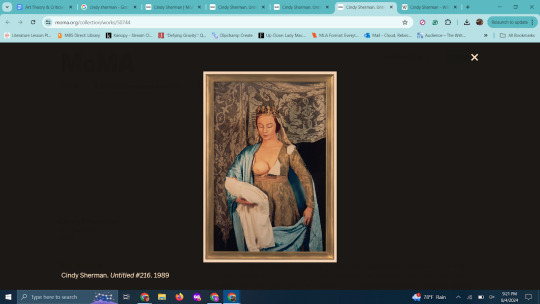
Barbara Kruger’s work is similar to Sherman’s in that it challenges stereotypes and the culture at large. However, Kruger’s work differs in that it draws on her background in page design and photo editing to combine text from magazines, television, video, and newspapers in order to challenge how we assign meaning to certain visual signifiers. She seeks to force us to question what we see and hear in the mainstream media and how that influences our identities and our society. I chose her work Untitled from 1986 because I believe it is the source of an internet meme I have been using for well over a decade now. “Intricate rituals” has been a reference in more than one online community I’ve been a part of, and even before I knew the source the phrase itself was challenging preconceived notions of intimacy, masculinity, and the overlap therein. The fact that her art speaks beyond the piece itself and has ingrained itself into the cultural lexicon shows the importance of the challenges she poses to the culture at large.
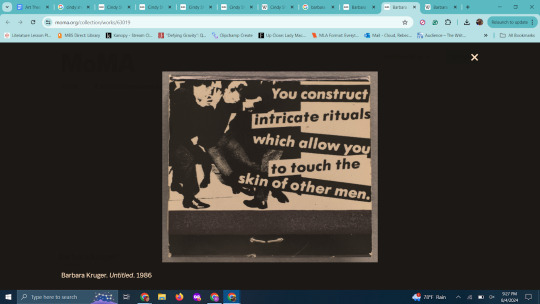
0 notes